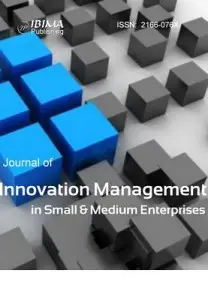Introduction
Small and medium-sized enterprises (SMEs) have been playing a critical role in growing Malaysia’s economy since the late 1990s (Chin & Lim, 2018), as well as being drivers of economic development, generating job opportunities, and promoting innovation (Haider, Asad & Fatima, 2017).Male entrepreneurship is being explored, however, previous studies have emphasized the emergence of female entrepreneurs who contribute to the economy and the social well-being (Sucheta Agarwal, 2018; Lenka & Agarwal, 2017; Yadav & Unni, 2016). Day by day, women entrepreneurs’ involvement has increased dramatically worldwide (Sucheta Agarwal, 2018). It has been nominated as the new engine for the economic growth, bringing prosperity and welfare in developing nations. As reported by Economic Census 2016 by the Department of Statistics Malaysia (DOSM) (2017), SMEs constitute 98.5% or 907,065 of business establishments in Malaysia, and 20.6% of them are wholly owned by women entrepreneurs with an annual growth rate of 8% (DOSM, 2017). Hence, women-controlled and women-owned businesses are now regarded as essential functional components of society and economy, comprising around 25.8% to 28.1% of the total entrepreneurs worldwide (Kumari Amrita, Chandra Prakash Garg, 2018). In Malaysia, women-owned SMEs are most probably underperformed because of a lack of intangible resources, as well as different behaviors or characteristics of female entrepreneurs compared to their male counterparts (Teoh & Chong, 2007). According to Ali Jafri & Khurram (2019), the difference between male and female entrepreneurs’ business performance is due to their intrinsic and discrete patterns of socialization and approach to their businesses.
Beside the number of women entrepreneurs, entrepreneurial competencies (EC) are one of the significant factors when it comes to performance (Chimucheka, 2018). The previous research revealed that EC are the vital criteria for the success of an enterprise, and several training programs focus primarily on enhancing the level of competencies among the small businesses in an attempt to broaden the competitive advantage and market performance (Ramadani, Gërguri, Dana & Tašaminova, 2013; Chimucheka, 2018).
Although EC are considered the crucial criteria to focus on, the other EC criterion, which is the entrepreneurial orientation (EO), is also stated as the key contributor to the women-owned SMEs (Rashid, 2017). In line with Ali Yassin (2013), the EO criteria have gained an increasing interest, yet, most of the studies were conducted among men-owned businesses as the criteria that affected the firms’ growth (Eggers, Kraus, Hughes, Laraway & Snycerski, 2013; Rashid, 2017). EO plays a vital role in the entrepreneur’s success in the growth of businesses and economic development (Arshad, Rasli, Arshad & Zain, 2014).
Thus, in general, the previous studies have been conducted to figure out EC and EO’s relationships towards women-owned SMEs’ business performance using SPSS (Mitchelmore & Rowley, 2013; Ali Yassin Sheikh Ali, 2014; Almubarak, 2016; Rashid, 2017). Nevertheless, the studies’ findings only proved the significance of the relationship and overlooked the measurement of ranking the most effective criteria that contributed to their performance. Therefore, this study investigates the measurement using an absolute scale by implementing AHP through several criteria and sub-criteria.
Literature Review
Women-owned SMEs
In this paper, women-owned SMEs are defined as businesses where a female is the owner-manager (Mckay, 2001; Subramaniam, P. & Islam, 2014), or where a woman or group of women initiate, organize and operate a business enterprise (Suganthi, 2009; Thayammal, 2011). As cited by Bakar et al. (2015), owner-managers have become the subject because they are the key informants of the business, and they are involved in the overall running of the firms.
Entrepreneurial Competencies (EC)
According to Kaur A. (2013), entrepreneurial competency is defined as the individual characteristics that are possessed by a person which result in new ventures creation, survival, and growth with primary characteristics such as basic and specific knowledge, motives, traits, self-image, roles and skills (Bird, 1995). In line with Man et al. (2002), EC, being defined as the entrepreneur’s entire capabilities to execute the job role fruitfully, consists of six major areas: an opportunity, organizing, strategic, relationship, commitment, and conceptual competencies.
Opportunity Recognition Competency
According to Man et al. (2002), this competency refers to the ability to recognize the opportunities in the market through various means. It is operationalized by measuring various behaviors such as identifying the services or products needed by the customers, perceiving unmet needs of the customers, looking for beneficial products and services for the customers, and availing the best opportunities. Parallel with Man et al. (2002) and Tang et al. (2012), entrepreneurs must be mindful of coordinating any accessible chance and asset that empower them to pick the holes.
Relationship Competency
According to Man et al. (2002), this perspective of building participation and trust utilizes associations, influential correspondence, and relational aptitudes. While according to Rowley (2013), individual and relationship competencies refer to the ability to haggle with others and maintain a good personal network of work contacts, developing long-term trusted and loyal relationships with others.
Conceptual Competency
Conceptual competency refers to the conceptual abilities reflected in the entrepreneurs’ behavior in making decisions regarding market opportunities and understanding the complex information to improve the businesses by using alternative solutions (Man & Lau, 2000; Mamun et al., 2019).
Organizing Competency
Organizing competency includes the organization of internal and external resources such as budget, materials, human resources, work schedule, and programs (Snell, Lau, Snell & Lau, 1994; Man et al., 2002; Kaur, A., 2013; Mamun et al., 2019) through building teams, managing employees, training, and controlling for better performance (Man & Lau, 2000; Bae & Rowley, 2004).
Strategic Competency
Strategic competency involves an entrepreneur’s ability to develop a business vision in mind, which is consistent with the literature of the entrepreneurial competency (Snell et al., 1994; Thompson et al., 1996; Mamun et al., 2019) by setting, evaluating and implementing the strategies of the firm (Man et al., 2002).
Commitment Competency
Commitment competency refers to the driver of an entrepreneur to continue business (Mamun et al., 2019), striving to achieve a long-term goal with strong devotion (Man & Lau, 2000). It is also defined as the effort or hard work that is required from entrepreneurs to manage their business (Sambasivan et al., 2010).
Entrepreneurial Orientation (EO)
EO is defined as a firm-level strategic orientation that captures an organization’s strategy-making practices, managerial philosophies, and firm behaviors that are entrepreneurial (Doris, 2016). As indicated by Green, Covin & Slevin (2008), entrepreneurial orientation is building strategic domain concepts including the specific firm-level outcomes and priorities related to management, beliefs, and behaviors that are expressed among the senior managers of a firm (Green, Covin & Slevin, 2008). EO is also determined as the specific strategic decisions and resource allocations in organizations (Edmon & Wiklund, 2010). In this study, EO is recognized by a three-dimensional conceptualization, namely, innovativeness, proactiveness, and risk-taking (Miller, 1983).
Risk Taking
Risk-taking is defined as the tendency to take bold actions such as venturing into unknown new markets, committing a large portion of resources to ventures with uncertain outcomes, and/or borrowing heavily (Dess & Lumpkin, 2001).
Innovativeness
The concept of innovativeness is described as the willingness to support creativity and experimentation in introducing new products/services. It is also described as using novelty, technological leadership, and research development (R&D) in developing new processes (Dess & Lumpkin, 2001).
Proactiveness
Proactiveness is the pursuit of opportunities and competitive rivalry in anticipating future demand by introducing new products or services to make changes and shape the business environment (Dess & Lumpkin, 2001).
Methodology
Multi-Criteria Decision Making
Previous research highlighted that the multi-criteria decision-making method (MCDM) effectively deals with the intrinsic multidimensionality, complexity, and subjectivity in the research area (Merad et al., 2013; Wang, 2015; Calabrese et al., 2019). The main attribute of MCDM is its emphasis on the judgment of group decision making, determining the objectives (goals) and criteria, estimating the weighted relative importance, and assessing the contributions of each option for each criterion (DCLG, 2009). Hence, the MCDM problems can be categorized into two groups, which are Multi-Objective Decision Making (MODM) and Multi-Attribute Decision Making (MADM) (Lu, Zhang, Ruan & Wu, 2007). In particular, AHP is a simple decision-making tool to deal with complex, unstructured, and multi-attributed problems (Saaty 1980; Esra Albayrak, 2004), and is widely used by decision-makers and researchers (Russo & Camanho, 2015). As supported by Tseng, Wu, Ma, Kuo & Sai (2017), AHP is a practical method that assists in decision making using a structural hierarchy with various criteria weighted by pairwise comparison. Hence, gauging the individual’s preferences and needs is a critical part of the different decision-making levels. Due to the numerous attributes of women-owned SMEs’ criteria, this may lead to difficulties in selecting the most effective criteria that affect the performance. Therefore, AHP, as an MCDM, will prescribe an accurate decision and help decision-makers find the one that best suits their needs and their understanding of the problem (Yang & Li, 2010).
Judgment Matrix and Consistency Test
In this paper, Super Decisions of AHP is a software package developed for the analysis, synthesis, and justification of complex decisions, with dependence feedback based on the analytic hierarchy process (AHP) methodology (Sharma, Gidwani, Sharma, & Meena, 2018). The scale method of grade 1-9 was used to determine the relative merits of the elements. Figure 3.1 shows the Super Decision model, and figure 3.2 shows the comparison between the parameters through a questionnaires survey form of women-owned SMEs using the absolute scale method 1-9 based on the principle and judgement matrix of AHP.
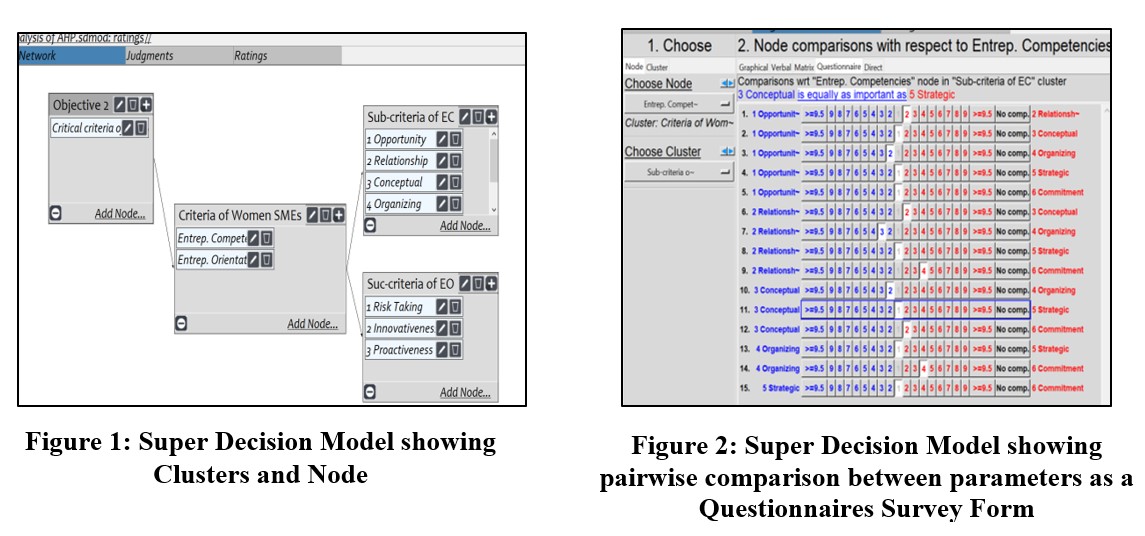
Figure 3 presents a two-stage process of methodology. Initially, the process was conducted to identify the criteria and sub-criteria of women-owned SMEs’ performance based on EC and EO. The systematic of the literature review has been conducted from the previous existing research. By reviewing the literature, the researcher has conducted a preliminary study to finalize women-owned SMEs’ critical criteria. The criteria of EC and EO have contributed to women-owned SMEs’ performance.
After conducting a preliminary study, the questionnaire surveys were designed and distributed to the selected respondents. The questionnaire consists of three sections: the demographic profile, criteria of women-owned SMEs, and sub-criteria of women-owned SMEs. The demographic profile will be analyzed using the Statistical Package for Social Science (SPSS) version 23. The next step was completed by applying the Super Decision software AHP method to calculate the weights of criteria and sub-criteria using an absolute value scale. Therefore, the ranking and assessment of the criteria and sub-criteria were analyzed after checking the comparison consistency. Based on the ranking results of AHP, the discussion and conclusion have been summarized.

Figure 3: The Process of Methodology
Results and Findings
Profile of Respondents
The demographic profile responses of the 128 survey respondents are illustrated in Table 1. The respondents are capable of evaluating the critical criteria of women-owned SMEs in Batu Pahat, Johor.
The age category for the respondents was analyzed to ensure the involvement of all age spans. The age of female owners of SMEs ranging from 31 to 35 years old was recorded as the highest score of 26.6 percent (n=34), followed by 36 to 40, which accounted for 24.2 percent (n=31).
The age of respondents in the range below 25 years old has the lowest percentage, 3.9 percent (n=5), due to a lack of business
confidence. As for the age between 26 and 30 years old, respondents were just about to set up their business, which also contributes to the low percentage which is only 7 percent (n=9). Next, the age of respondents in the range from 41 to 45 years, 46 to 50 years, and above 50 years old, is represented by 14.1 percent (n=18), 13.30%(n=17), and 10.9 percent (n=14), respectively.
The next section of the demographic analysis presents the respondents’ age when they have started to own or manage their businesses. The majority of them have started their businesses below 25 years old, with a total percentage of 37.6 percent (n=47). Female owner-managers ranging from 26 to 30 years old account for 18.6 percent (n=24), followed by 16.4 percent (n=21) for those aged 36 to 40. The range of age between 31 and 35 accounted for 15.6 percent (n=20), and then 10.2 percent (n=13) for those in the range of 41 to 45 years old, and followed gradually by only 2.3 percent (n=3) for those over 50 years old.
In terms of the marital status, three options were given in the survey: single, married, or widow. According to the overall respondents, the majority of them, with 79.7 percent (n=102), stated that they are married, while the percentages of those who are single or widowed accounted for 9.4 percent (n=12) and 10.90% (n=14), respectively.
Concerning nationality, most of the respondents are Malay, representing 76.6 percent (n=98) of the population sample, 22 Chinese (17.2 percent), and 14 Indians (6.3 percent). The next section of the descriptive analysis of the respondents will explain the number of children respondents have. The number of children for respondents between 1 and 3 accounted for the highest percentage, 43 percent (n=55), and followed by 4 to 6 children, which accounted for 29.7 percent (n=38). Despite that, 22.7 percent (n=29) of the respondents does not have children, and 4.7 percent (n=6) have more than six children.
Concerning the educational background, respondents who finished their secondary school accounted for 57.8 percent (n=74), while those who obtained their diploma accounted for 28.9 percent (n=37), and first degree accounted for 10.2 percent (n=13). The lowest education level was primary school, which accounted for 3.1 percent (n=4).
In terms of the working experience, most of the respondents have a total working experience between 1 and 5 years, which accounted for 30.5 percent (n=39), followed by 27.3 percent (n=35) of those with working experience from 6 to10 years. A percentage of 22.7 percent (n=29) represented respondents with 11 to 15 years of working experience, 10.2 percent (n=13) for those with more than 20 years working experience, and finally, 4.7 percent (n=6) for those with working experience less than one year and those with 16 to 20 years of working experience.
Table 1 shows the respondents’ years of experience with the firm. A percentage of 45.3 percent (n=58) represented those who have been with the firm between 1 and 5 years, 28.1 percent (n=36) for those who have been with the firm between 6 and 10 years, 13.3 percent (n=17) for those who have been with the firm between 11 and 15 years, 6.3 percent (n=8) for those who have been with firm for less than one year, 3.1 percent (n=4) for respondents who have been with the firm between 16 and 20 years, and 3.9 percent (n=5) for those who have been with the firm for more than 20 years.
Table 1: Analysis of Profile Respondents
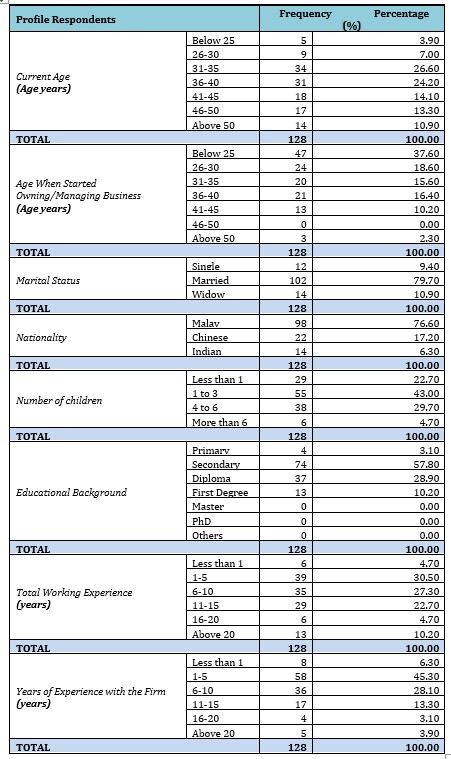
Results of Decision AHP
The criteria and sub-criteria of women-owned SMEs were analyzed using the Super Decision V3 software of AHP. These comparisons were used to obtain the weights of importance for the decision criteria. The results obtained were used to rank the most important criteria for women-owned SMEs for better performance. Meanwhile, Table 2 until Table 4 show the theoretical matrix representing the questionnaire survey form for criteria and sub-criteria of women owner-managers based on the pairwise comparison. Based on the results, the ranking of important criteria and sub-criteria is recorded in Table 5 below.
Table 2: Theoretical Matrix representation of a Questionnaire Survey
Form for Criteria of Women-SMEs’ Performance
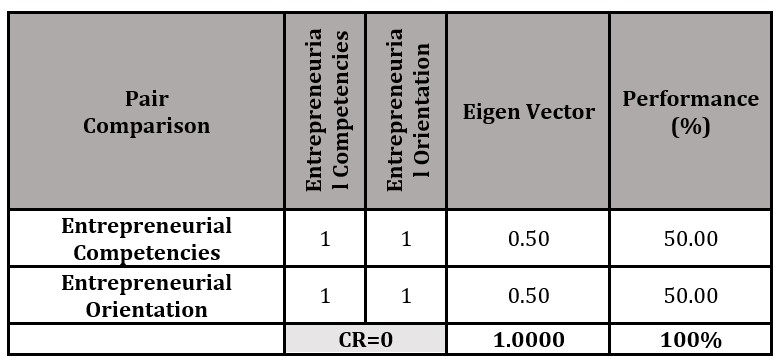
Based on the findings that the researcher had analyzed for the 128 respondents, the Consistency Ratio (CR) for women-owned SMEs’ criteria is equal to zero. CR will give value if the paired comparison is more than two criteria, and the consistency applies only to the pairwise comparison matrices. For the Eigen Vector, the value for EC and EO are evaluated as equally important, which signifies that 50 percent of both criteria contribute to women-owned SMEs’ performance. After comparing the main criteria, all sub-criteria have also been compared to their groups.
Table 3: Theoretical Matrix representation of a Questionnaire Survey Form for
Sub-Criteria (EC) of Women-SMEs’ Performance
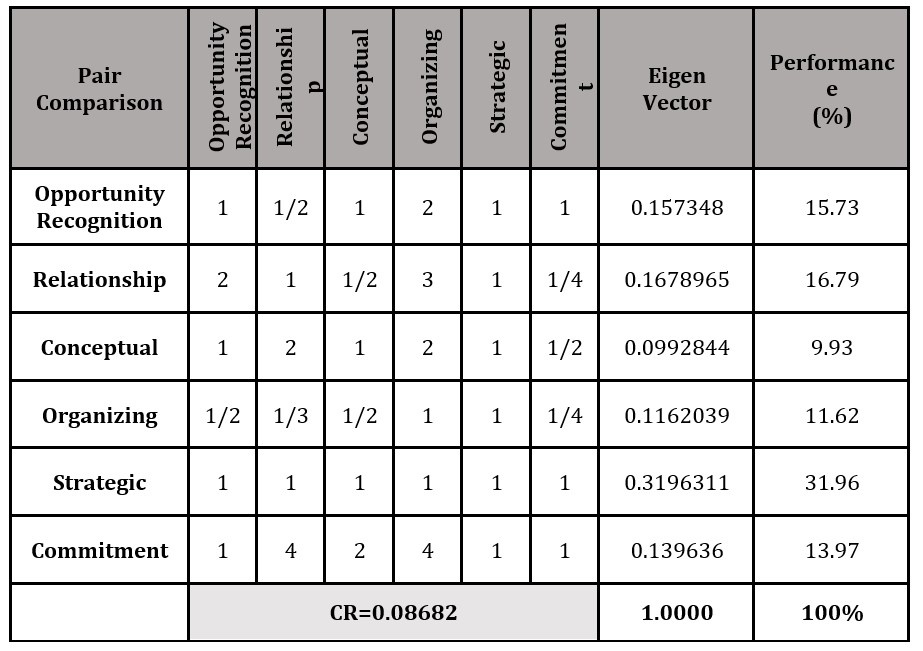
Table 3 reports the comparison matrices between EC’s sub-criteria for the overall respondents with the CR=0.08682 < 0.1. The evaluation of the important criteria of women-owned SMEs' performance is being considered as acceptable. The paired comparison for strategic has contributed the highest percentage, with 31.96 percent, to women-owned SMEs’ performance, according to 128 respondents in Batu Pahat. It means that women owner-managers in Batu Pahat have concluded that strategy is one of the most important sub-criteria in improving their business performance. Meanwhile, the percentage that of relationship gives 16.79 percent, followed by opportunity recognition 15.73 percent, commitment 13.97 percent, and 11.62 percent for organizing. The lowest percentage of the sub-criteria of EC is for conceptual, with 9.93 percent.
Table 4: Theoretical Matrix representation of a Questionnaire Survey Form for
Sub-Criteria (EO) of Women-owned SMEs’ Performance
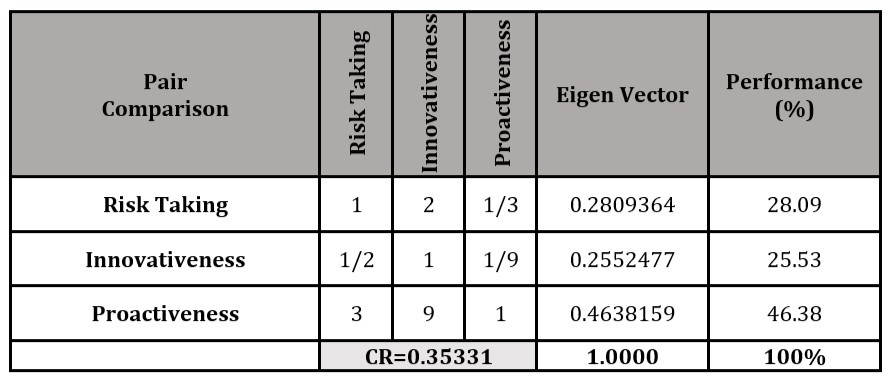
Table 4 reports the pair comparison matrices between the sub-criteria of EO with CR=0.35331, > 0.1. The consistency is desirable to be less than 0.10 or 10%. Each of the respondents was considered, and the consistency was possible to improve if it was above 0.10. However, it has limitations while trying to improve it as it should be
convincing. Due to limited knowledge and unawareness of others, this will make the results inconsistent (Natee et al., 2016). To summarize the results, the percentage of proactiveness has contributed with 46.38 percent, followed by risk-taking with 28.09 percent, and innovativeness with 25.53 percent.
Table 5: Rank of Importance Criteria and Sub-criteria of Women-owned SMEs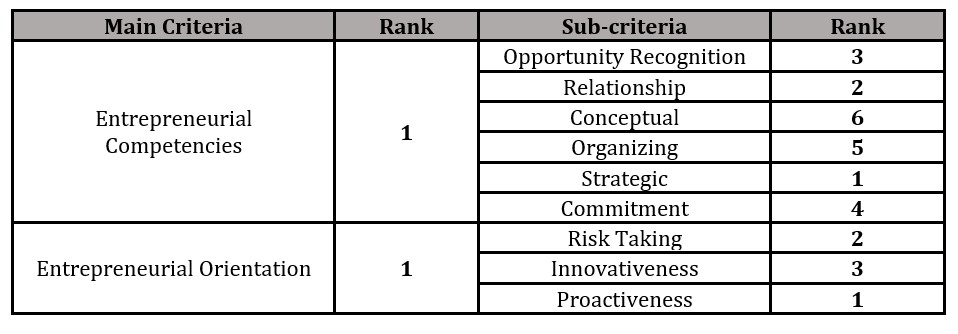
After the pairwise comparison matrix is formed, the measurement’s priority vector and consistency are being calculated based on the method explained. The data were obtained from the respondents in Batu Pahat. Based on the overall result for the 128 respondents, the ranking of important criteria and sub-criteria of women owner-managers were recorded, which contribute to the average result of EC and EO. However, based on EC’s sub-criteria, the most important sub-criterion is strategic as it was categorized in the first rank, followed by relationship, opportunity recognition, commitment, organizing, and the last is conceptual. Then, for EO’s sub-criteria, proactiveness is recorded as the first rank, followed by risk-taking and innovativeness.
Discussion And Conclusion
This study aims to identify the criteria of women-owned SMEs’ performance, EC and EO, using the Super Decision of AHP method. The findings indicate that EC and EO’s ranking criteria are equally important for women-owned SMEs’ performance. Moreover, the consistency ratio (CR) was found important too. Consequently, SMEs will give value if the pair comparison is more than two criteria, and the consistency applies only to the pairwise comparison matrices. Based on the previous research, EO and EC were significantly related to women-owned SMEs’ business performance (Rashid, 2017; Zainol, 2018). However, previous studies focused only on the relationship between SMEs and EC of women-owned SMEs towards performance and overlooked the ranking of performance, which is important to be studied in this paper. Thus, this study is important for women entrepreneurs as it serves as a guideline to improve their skills, knowledge and entrepreneurial elements in order to make their business more successful. This research was contribute to the existing body of knowledge in women entrepreneurs’ study and entrepreneurship literature towards improving the SMEs’ performance. The theoretical contributions and practical implications will contribute to better findings for women owners/managers of SMEs and women entrepreneurial development in Malaysia. Finally, it is further hoped that better results will help boost the growth of women-owned SMEs, which are crucial to developing the economy.
Limitation And Recommendation
This paper encounters a few limitations, which are first based on the criteria of EO. Therefore, the data collected may be affected due to CR because the consistency is above 0.10. Even though the CR has been tested and was found acceptable in this research, it may invariably affect the results’ accuracy. Therefore, the current study recommends using the combination method with a qualitative methodology, such as the Delphi method, to complement the pairwise comparison in future research. Secondly, the findings and conclusions drawn from this research might not be limited to one state only, including other states in Malaysia. As for that, the results may not be applicable since they only focused on a limited area. Thus, the results could be broader, and they can be compared to other states to examine generalisability. Finally, while these findings of the research allude to the importance of criteria for women-owned SMEs, the critical criteria of women-owned SMEs’ performance are not examined. Therefore, future research can be considered to examine these effects. This will draw superior implications and maximize their business performance by focusing on the criteria that yield countless impacts on SMEs’ business performance.
Acknowledgement
The authors would like to thank the Ministry of Higher Education in Malaysia for supporting this research under the Fundamental Research Grant Scheme Vot No. FRGS/1/2018/SS03/UTHM/03/5 and partially sponsored by Universiti TunHussein Onn Malaysia (UTHM).
(adsbygoogle = window.adsbygoogle || []).push({});
References
- Ali Jafri, S. K., & Khurram, W. (2019). Distinction or Discrimination?A Qualitative Study of Sustainable growth of Women-Owned Technology based SMEs in Malaysia. International Journal on Perceptive and Cognitive Computing, 5(2), 6–11. https://doi.org/10.31436/ijpcc.v5i2.122
- Ali Yassin Sheikh Ali, A. H. A. (2013). Entrepreneurial Orientation and Performance of Women-Onwed Enterprise in Su-Saharan African Context : A case of Somalia. (December 2013).
- Ali Yassin Sheikh Ali, A. H. A. (2014). Entrepreneurial Orientation And Performance Of Women Owned Entrepreneurial Orientation And Performance Of Women Owned And Managed Micro And Small. (February 2014).
- Almubarak, M. (2016). Factors Influencing Women Entrepreneurs ’ Performance in SMEs World Journal of Entrepreneurship , Management and Sustainable Article information : (November).
- Arshad, A. S., Rasli, A., Arshad, A. A., & Zain, Z. M. (2014). The Impact of Entrepreneurial Orientation on Business Performance: A Study of Technology-based SMEs in Malaysia. Procedia – Social and Behavioral Sciences, 130, 46–53. https://doi.org/10.1016/j.sbspro.2014.04.006
- Bae, J., & Rowley, C. (2004). Macro and micro approaches in human resource development: Context and content in South Korea. Journal of World Business, 39(4), 349–361. https://doi.org/10.1016/j.jwb.2004.08.003
- Bakar, H. A., Mahmood, R., & Ismail, N. N. H. (2015). Effects of knowledge management and strategic improvisation on SME performance in Malaysia. Asian Social Science, 11(9), 207–214. https://doi.org/10.5539/ass.v11n9p207
- Bird, B. (1995). Towards a theory of entrepreneurial competency”, Advances in entrepreneurship, firm emergence and growth. 2(Vol. 2 No. 1, p.), 51–72.
- Calabrese, A., Costa, R., Levialdi, N., & Menichini, T. (2019). Integrating sustainability into strategic decision-making: A fuzzy AHP method for the selection of relevant sustainability issues. Technological Forecasting and Social Change, 139(November), 155–168. https://doi.org/10.1016/j.techfore.2018.11.005
- Chimucheka, T. (2018). The Importance Of Entrepreneurial Competencies On The Performance Of Women Entrepreneurs In South Africa. (March). https://doi.org/10.19030/jabr.v34i2.10122
- Chin, Y.-W., & Lim, E.-S. (2018). SME Policies and Performance in Malaysia. 41. Retrieved from https://www.iseas.edu.sg/images/pdf/ISEAS_EWP_2018-3_ChinLim.pdf
- Dess, G. G., & Lumpkin, G. . (2001). Linking two dimensions of entrepreneurial orientation to firm performance. Journal of Business Venturing, 16(5), 429–451. https://doi.org/10.1016/S0883-9026(00)00048-3
- Doris, N. (2016). Factors Influencing the Performance of Female Owned Enterprises: a Case of Businesses in the Central Business District of Nairobi, Kenya. Thesis of Master Degree.
- Eggers, F., Kraus, S., Hughes, M., Laraway, S., & Snycerski, S. (2013). Implications of customer and entrepreneurial orientations for SME growth. Management Decision, 51(3), 524–546. https://doi.org/10.1108/00251741311309643
- Esra Albayrak, Y. C. E. (2004). Using analytic hierarchy process ( AHP ) to improve human performance : An application of multiple criteria decision making problem. Journal of Intelligent Manufacturing, 15, 491–503. https://doi.org/10.1023/B:JIMS.0000034112.00652.4c
- Government, D. for C. and L. (2009). Multi-Criteria Analysis : A Manual. Department for Communities and Local Government (DGLG), London.
- Green, K. M., Covin, J. G., & Slevin, D. P. (2008). Exploring the relationship between strategic reactiveness and entrepreneurial orientation: The role of structure-style fit. Journal of Business Venturing, 23(3), 356–383. https://doi.org/10.1016/j.jbusvent.2007.01.002
- Kaur , H. & B. (2013). Understanding the concept of entrepreneur competency. Journal of Business Management & Social Sciences Research (JBM&SSR), 2(11), 31–33. Retrieved from http://www.borjournals.com
- Kaur A., H. & B. (2013). Understanding the concept of entrepreneur competency. Journal of Business Management & Social Sciences Research (JBM&SSR), 2(11), 31–33. Retrieved from http://www.borjournals.com
- Kumari Amrita, Chandra Prakash Garg, S. S. (2018). Modelling the critical success factors of women entrepreneurship using Fuzzy AHP framework. Journal of Entrepreneurship in Emerging Economies. https://doi.org/https://doi.org/10.1108/JEEE-03-2017-0017
- Lenka, U., & Agarwal, S. (2017). Does growth of ventures depend on competencies?: selected cases from India. International Journal of Entrepreneurship and Small Business, 31(2), 227. https://doi.org/10.1504/ijesb.2017.10004850
- Lu, J., Zhang, G., Ruan, D., & Wu, F. (2007). Multi-objective Group Decision Making: Methods, Software and Applications with Fuzzy Set Techniques. Retrieved from https://books.google.com.my/books?hl=en&lr=&id=669gDQAAQBAJ&oi=fnd&pg=PR5&dq=multi-objective+group+decision+making+methods+software+and+applications&ots=FvxE50Vw2t&sig=duJmQ94b9i3sNDH-OVdx1exokZY#v=onepage&q=multi-objective group decision making methods s
- Malaysia, D. of S. (2017). Department Of Statistics Malaysia Press Release Profile Of Small And Medium Enterprises Economic Census 2016. (September).
- Mamun, A. Al, Fazal, S. A., & Zainol, N. R. (2019). Economic Vulnerability , Entrepreneurial Competencies , and Performance of Informal. Journal of Poverty, 0(0), 1–22. https://doi.org/10.1080/10875549.2019.1587676
- Man, T. W. Y., & Lau, T. (2000). Entrepreneurial Competencies of Sme. Journal of Enterprising Culture, 8(3), 235–254.
- Man, Thomas W Y, Lau, T., & Chan, K. F. (2002). The competitiveness of small and medium enterprises A conceptualization with focus on entrepreneurial competencies $. 17(June 1998), 123–142.
- Mckay, R. (2001). Women entrepreneurs: Moving beyond family and flexibility. International Journal of Entrepreneurial Behaviour & Research, 7(4), 148–165. https://doi.org/10.1108/EUM0000000005764
- Merad, M., Dechy, N., Serir, L., Grabisch, M., & Marcel, F. (2013). Using a multi-criteria decision aid methodology to implement sustainable development principles within an organization. European Journal of Operational Research, 224(3), 603–613. https://doi.org/10.1016/j.ejor.2012.08.019
- Miller, D. (1983). The Correlates of Entrepreneurship in Three Types of Firms. Management Science, 29(7), 770–791. https://doi.org/10.1287/mnsc.29.7.770
- Natee, S., Pheng, S., & Evelyn, L. (2016). Quality Function Deployment for Buildable and Sustainable Construction.
- Noor Raihani Zainol, A. A. M. (2018). Entrepreneurial competency , competitive advantage and performance of informal women micro-entrepreneurs in Kelantan , Malaysia. Journal of Enterprising Communities: People and Places in the Global Economy. https://doi.org/10.1108/JEC-11-2017-0090
- Edmon, V. & J. W. (2010). The historic roots of entrepreneurial orientation research. In: Landström H and Lohrke F (eds). Cheltenham: Edward Elgar. In The Historical Foundations of Entrepreneurship Research (pp. 142–160). Retrieved from https://books.google.com.my/books?hl=en&lr=&id=BB7Zes_BZtgC&oi=fnd&pg=PA142&dq=Edmond+V+and+Wiklund+J+(2010)+The+historic+roots+of+entrepreneurial+orientation+research.+In:+Landström+H+and+Lohrke+F+(eds)The+Historical+Foundations+of+Entrepreneurship+Resea
- Prem Rose Thayammal, I. (2011). A study on the development of women entrepreneurs in small scale industries in tirunelveli district.
- Ramadani, V., Gërguri, S., Dana, L. P., & Tašaminova, T. (2013). Women entrepreneurs in the Republic of Macedonia: waiting for directions. International Journal of Entrepreneurship and Small Business, 19(1), 95. https://doi.org/10.1504/ijesb.2013.054330
- Rashid, U. K. B. (2017). The Effect of Entrepreneurial Management, Entrepreneurial Orientation and Ethics On The Women-Owned SMEs Business Performance in Malaysia. Universiti Utara Malaysia.
- Rowley, J. (2013). Entrepreneurial competencies of women entrepreneurs pursuing business growth. Journal of Small Business and Enterprise Development, 20(1), 125–142. https://doi.org/10.1108/14626001311298448
- Russo, R. D. F. S. M., & Camanho, R. (2015). Criteria in AHP: A systematic review of literature. Procedia Computer Science, 55(Itqm), 1123–1132. https://doi.org/10.1016/j.procs.2015.07.081
- Saaty, T. L. (1980). The Analytic Hierarchy Process. McGraw- Hill International, New York, NY, USA.
- Sambasivan, M., Li-Yen, L., Che-Rose, R., & Abdul, M. (2010). Venture Performance in Malaysia: Personal Initiative, Human Capital, and Competency Areas of Founding Entrepreneurs as Critical Success Factors. Journal of Small Business and Entrepreneurship, 23(3), 315–332. https://doi.org/10.1080/08276331.2010.10593488
- Sharma, V., Gidwani, B. D., Sharma, V., & Meena, M. L. (2018). Implementation model for cellular manufacturing system using AHP and ANP approach. Benchmarking, 26(5), 1605–1630. https://doi.org/10.1108/BIJ-08-2018-0253
- Snell, R., Lau, A., Snell, R., & Lau, A. (1994). Salient for Expanding Small.
- Subramaniam, P., & Islam, J. (2014). Innovation and the impact of technology on women entrepreneurs in small and medium enterprises in Singapore. , 30, 238–246. doi: World Applied Sciences Journal, (30), 238–246. https://doi.org/10.5829/idosi.wasj.2014.30.icmrp.31
- Sucheta Agarwal, V. A. (2018). Motivational and success factors : through the lens of women entrepreneurship Sucheta Agarwal * and Vivek Agrawal. 17(4).
- Suganthi, J. (2009). Influence of Motivational Factors on Women Entrepreneurs in SMEs. V(1), 95–104.
- Syed Hussain Haider, Muzaffar Asad, M. F. (2017). Entrepreneurial Orientation and Business Performance of Manufacturing Sector Small and Medium Scale Enterprises of Punjab Pakistan. European Business & Management, 3(2), 21. https://doi.org/10.11648/j.ebm.20170302.12
- Tang, J., Kacmar, K. M. M., & Busenitz, L. (2012). Entrepreneurial alertness in the pursuit of new opportunities. Journal of Business Venturing, 27(1), 77–94. https://doi.org/10.1016/j.jbusvent.2010.07.001
- Thompson, J. E., Stuart, R., Lindsay, P. R., Thompson, J. E., Stuart, R., & Lindsay, P. R. (1996). performance.
- Tseng, M. L., Wu, K. J., Ma, L., Kuo, T. C., & Sai, F. (2017). A hierarchical framework for assessing corporate sustainability performance using a hybrid fuzzy synthetic method-DEMATEL. Technological Forecasting and Social Change, 144(October), 524–533. https://doi.org/10.1016/j.techfore.2017.10.014
- Wang, X. (2015). A comprehensive decision making model for the evaluation of green operations initiatives. Technological Forecasting and Social Change, 95, 191–207. https://doi.org/10.1016/j.techfore.2015.02.004
- Wendy Ming-Yen, Teoh, S.-C. C. (2007). Theorising A Framework Of Factors Influencing Performance Of Women Entrepreneurs In Malaysia. III(2).
- Yadav, V., & Unni, J. (2016). Women entrepreneurship: research review and future directions. Journal of Global Entrepreneurship Research, 6(1). https://doi.org/10.1186/s40497-016-0055-x
- Yang, S., & Li, C. (2010). An enhanced routing method with Dijkstra algorithm and AHP analysis in GIS-based emergency plan. 2010 18th International Conference on Geoinformatics, Geoinformatics 2010. https://doi.org/10.1109/GEOINFORMATICS.2010.5567840.



